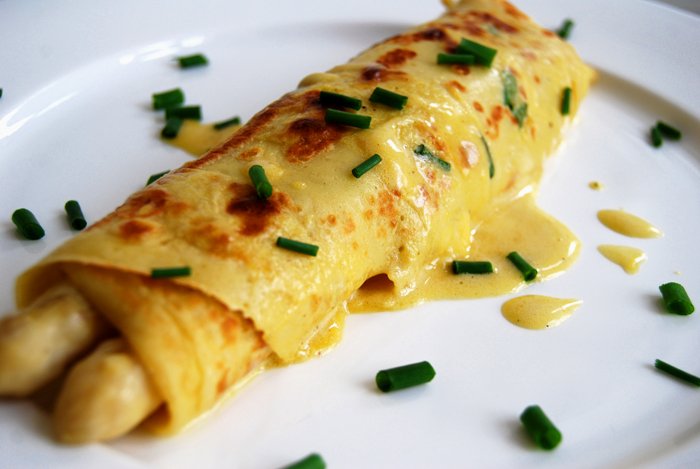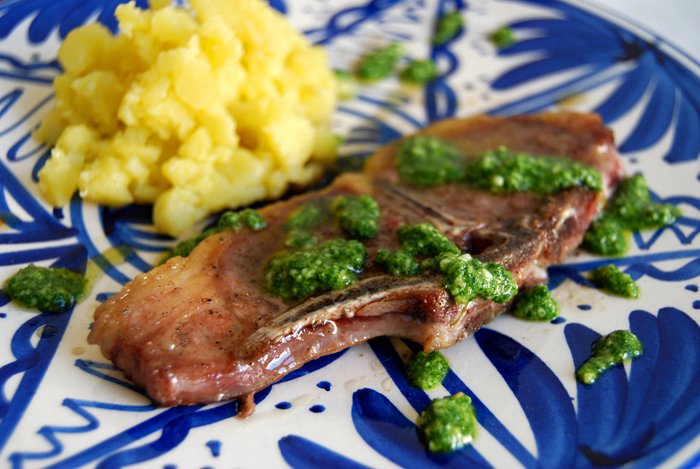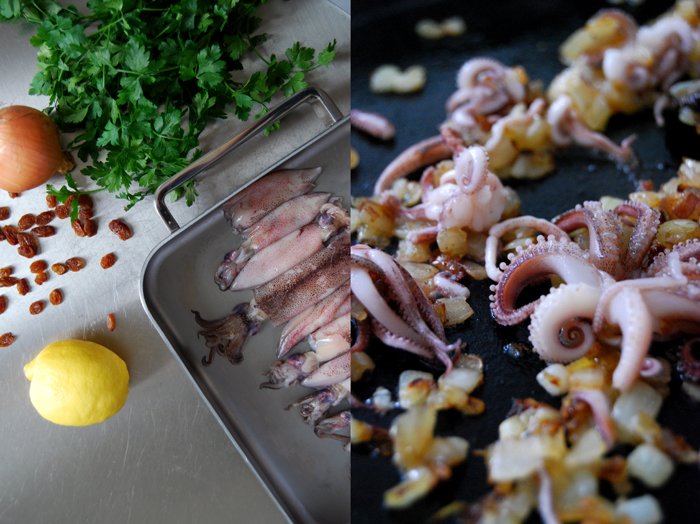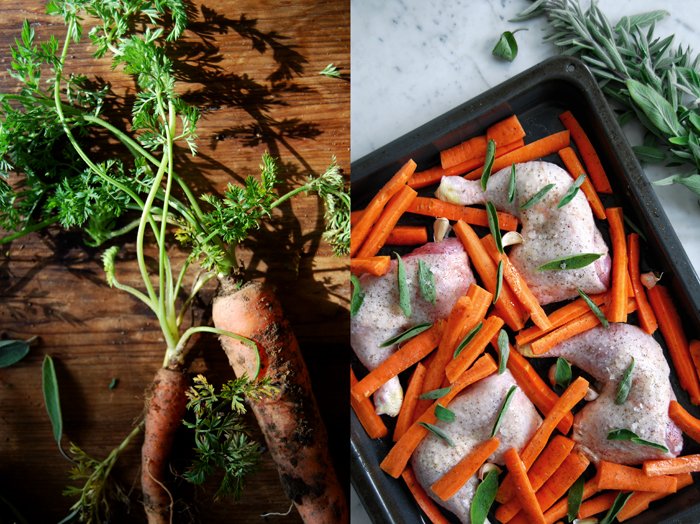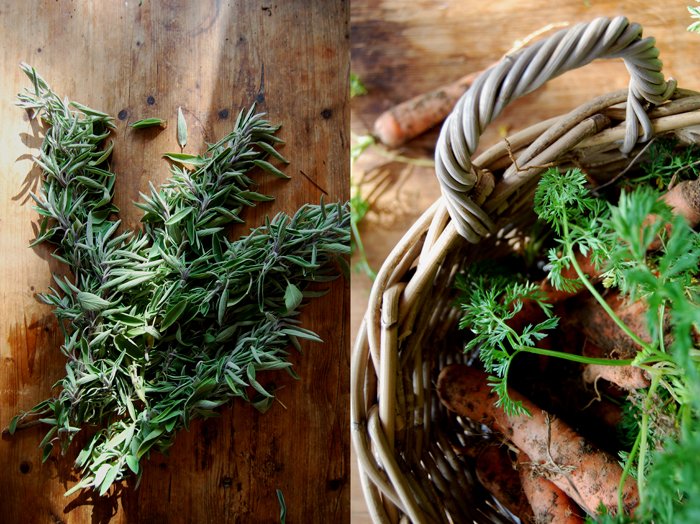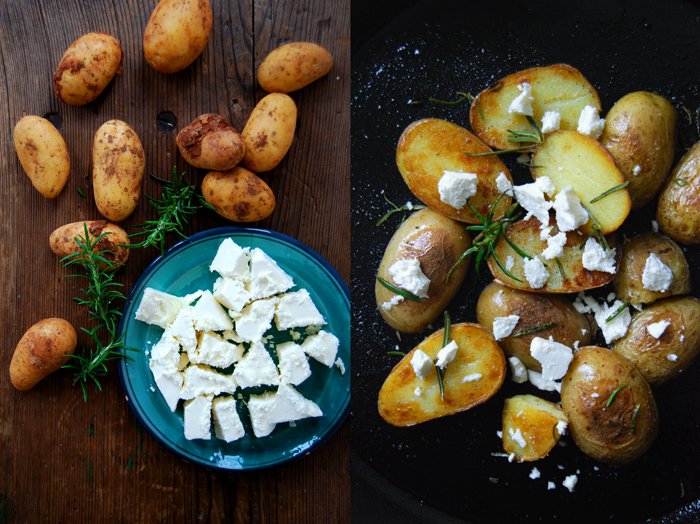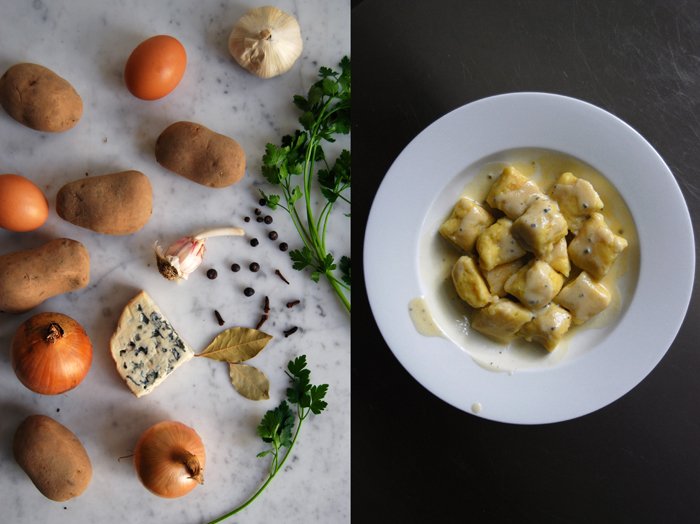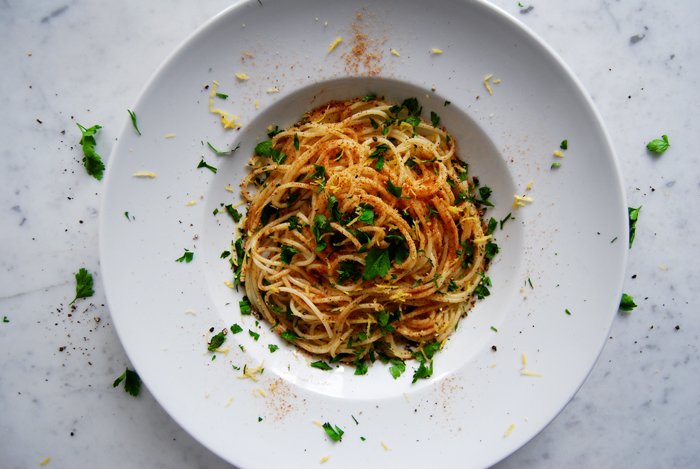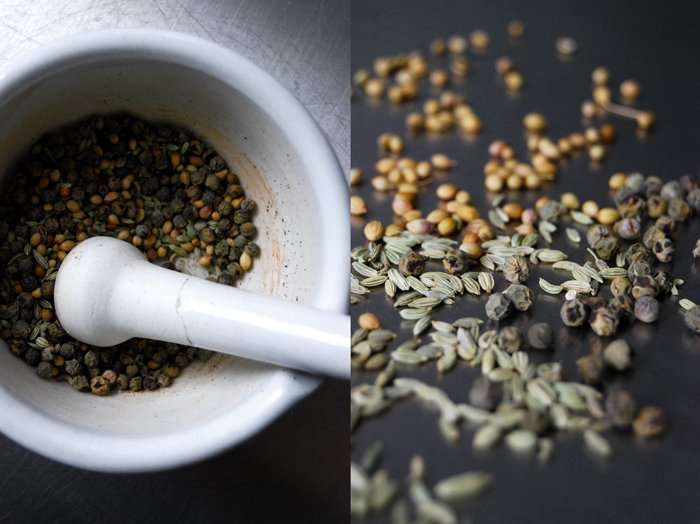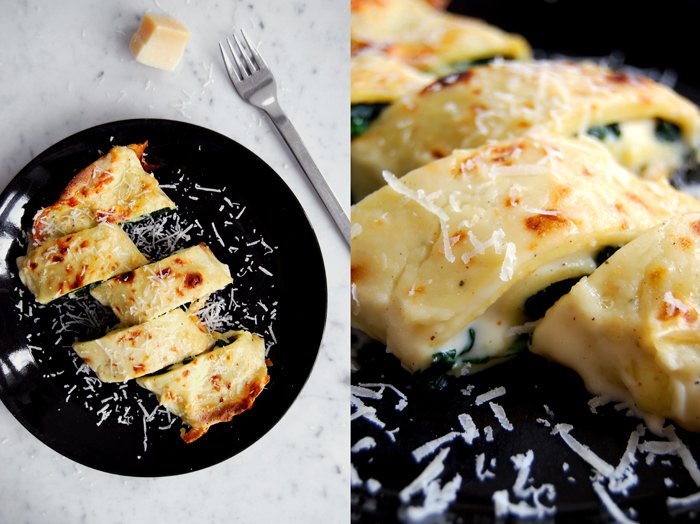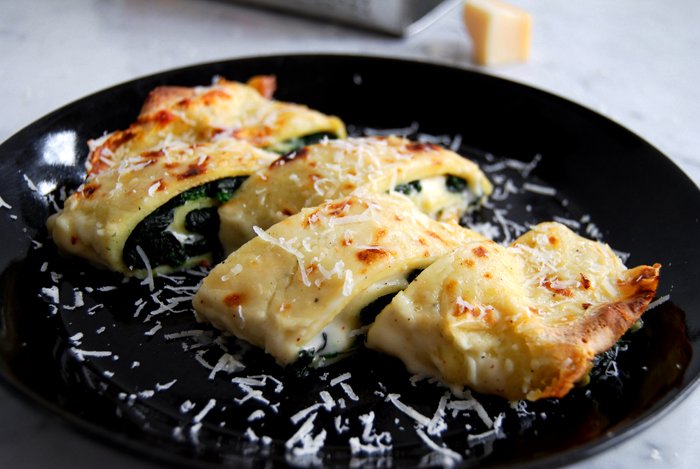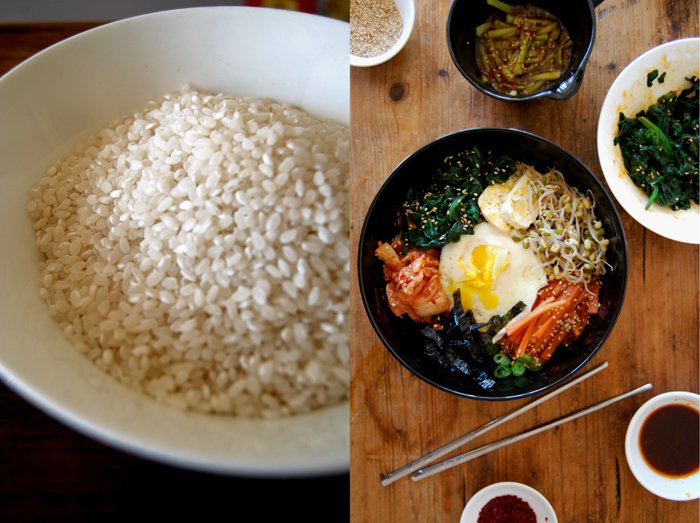White Asparagus wrapped in Crêpes with Sauce Hollandaise
A bag full of white asparagus is laying on my kitchen top, so crunchy and fresh, that its juices start running as soon as I cut the bottoms off. Their short season which ends in late May or early June has just started. It's a delicate gem, also referred to as the royal vegetable, white gold or edible ivory. While green asparagus grows above the ground, the white shoots stay covered in soil and ripen in the dark which prevents photosynthesis, hence the white colour. This technique is called blanching in horticulture, it creates a delicate flavour and makes them tender and less bitter. Unlike their green relatives, white asparagus has to be peeled and also needs to cook a little longer, around 8 minutes to keep them al dente.
One of the most common recipes which puts the focus on the pure taste of the asparagus, is white asparagus served in brown butter with breadcrumbs and slices of cooked ham and new potatoes on the side. A very popular variation on this meal which is also my favourite, is to replace the butter with a sauce Hollandaise, homemade of course as it's not as complicated as one may fear. The taste of this sauce, buttery, eggy, enhanced with Dijon mustard and lemon brings the best out of this royal vegetable. There is some helpful information put together on Food52 for dressings which demand emulsification like sauce Hollandaise or aioli.
I wrapped my first white asparagus of the year in thin crêpes with chives and baked them with a thick and fluffy sauce Hollandaise under the grill, just for a few minutes until it had a golden bubbly crust.
White Asparagus wrapped in Crêpes with Sauce Hollandaise
For 4 people you need
white asparagus, peeled, the bottoms cut off, 1.5kg / 3 pounds
In a large pot, cook the asparagus in plenty of salted water for about 8 minutes till al dente.
For the crêpe
organic eggs 4
milk 400ml
plain flour, sieved, 200g / 7 ounces
salt 1 teaspoon
chives, chopped, 1 bunch
Whisk or mix the ingredients for the pancakes until well combined, stir in the chives at the end. Fry the crêpes thinly in a large non-stick pan in a little butter for 1-2 minutes. They should be golden on both sides.
For the sauce Hollandaise
butter melted 120g / 4.5 ounces
organic egg yolks 4water 4 tablespoons
freshly squeezed lemon juice 2 tablespoons
Dijon mustard 2 tablespoons
salt and black pepper
In a sauce pan, whisk the egg yolks with the water, lemon juice, mustard, salt and pepper for the sauce Hollandaise till fluffy. Put the pan on a low temperature, the pot should become warm but not hot. Whisk the melted butter into the egg mixtures, adding just a tablespoon at a time and whisk well in between. If the sauce becomes too hot, take it off the heat immediately or add a little more water. When its all combined continue whisking for 1-2 minutes, off the heat if it's already thick and creamy or on the heat, but mind the temperature. Season with salt and pepper and more mustard to taste.
For the crêpe roll
Roll 2-3 asparagus in each crêpe, put the wraps flat onto a large baking dish and pour the sauce over it. Bake under the grill for a couple minutes until the sauce starts bubbling and turns a golden brown. Serve immediately.
If you don't need all of the sauce for the asparagus you can keep it in the fridge until the next day and eat it with potatoes or mixed in an omelet, both are great with chopped chives!
Lamb Chops with Rucola Pesto and Mediterranean Mashed Potatoes
My young sister in law came to visit us and brought a big appetite with her! She loves food as much as I do but she enjoys eating more than cooking so whenever I'm cooking and pottering about in my kitchen she joins in with excitement. She gives me a helping hand or sits at the table patiently to see what's in the pots and pans as soon as I lift their lids. When I visit her at her home in Malta, we always make lots of pesto together. We walk through the garden with the two beautiful orange and lemon trees packed with fruits and pick the herbs growing around them, plenty of basil, parsley, peppermint and rucola. When I touch the leaves and they spread their smell in the warm air I can already taste the pesto! Everything grows so fast and strong under the Mediterranean sun that I can't stop myself from picking bowls full of fragrant leaves to fill big jars with my pesto which we still manage to empty within a couple days. We mix it with dried tomatoes, pine nuts, parmesan or pecorino, black or green olives and eat it with pasta, on bread or potatoes and in salads. Every pesto tastes different, it's never the same, that's what I love about it!
Since we have our own personal pesto tradition, I wanted to make some while Julia is here. I already made one with ramp (and she emptied the jar with her fingers) and now it's rucola! I sprinkled the pesto on some juicy lamb chops, sautéed for a minute on each side and served them with mashed potatoes. For the mash, I just chopped the cooked potatoes with a knife until they had a lumpy texture and mixed olive oil and sea salt in, no butter or milk, I wanted to keep it light and Mediterranean!
The lamb was great together with the spicy rucola, the meat's juices mixed in perfectly with the herb, but the secret star of this meal was the mashed potatoes together with the pesto which I hadn't even planned to mix together. The big pot of mashed potatoes and the bowl of pesto were emptied within minutes!
Lamb Chops with Rucola Pesto and Mashed Potatoes with Olive Oil
For 4 people you need
lamb chops, 4-8 (depending on if you have a starter before), around 100g / 3.5 ounces per person
olive oil for frying
rosemary 1 sprig
garlic, cut in half, 1
For the mashed potatoes
medium sized potatoes, peeled and cooked in salted water, 12
olive oil 40ml
sea salt
For the pesto
rucola (arugula), 60g / 2 ounces
Parmesan 20g / 3/4 ounce
pine nuts 20g / 3/4 ounce
olive oil 75 ml
a pinch of salt
Mix the ingredients for the pesto in a blender.
In a large pot, chop the warm potatoes with a knife until they have a lumpy texture adding the oil constantly, season with salt.
Heat a little olive oil in a pan over high temperature together with the rosemary and garlic. Lay the lamb chops in the pan, turn the temperature down to a medium heat and sauté the meat for 1 minute on each side until it colours. Don't overcook them as the meat should remain juicy. Depending on the size of your pan you have to cook them in batches and keep them warm under a plate or wrapped in aluminum foil but keep in mind that they will continue cooking when they are covered.
Place the meat on warm plates sprinkled with the pesto and serve with the mashed potatoes.
Bean and Ramp Quiche
Quiche is one of those dishes which makes me feel good, always, no matter what my day has been like. As soon as I see a quiche in my oven and smell its buttery aroma spread through the kitchen I have to smile. Maybe it's the butter, or the eggs or the fact that I can look forward to another tart on my plate! That's why I've already written about a couple of my quiche recipes, my classic quiche with leek, tomatoes and thyme, an Italian-style tart with fennel and parmesan and here is another one, packed with greens. I fill this savory tart with beans, ramp (wild garlic) and spring onions and it has a deliciously light spring feeling!
I've praised its short crust at length which is so crisp and buttery, to me it's just perfect. My quiches always have a thin layer of an eggy and creamy mixture to keep it light and to leave space for the vegetable filling. Some recipes focus on the creamy filling which can make a quiche too rich and heavy, at least for my taste. I want to be able to eat a piece of quiche with my fingers, a tart for a picnic!
Bean and Ramp Quiche
For one quiche you need a round (27cm / 10.5″) or oval baking dish or tart pan.
For the short crust base
flour 250g / 8.5 ounces (I use spelt flour type 630 but you can use any other plain flour)
butter, cold 125g / 4.5 ounces
organic egg 1
salt 1 teaspoon
Combine the flour with the salt. Cut the butter with a knife into the flour until there are just little pieces of butter left. Continue with your fingers and work the butter into the flour until combined (there shouldn’t be any lumps of butter left). Add the egg and continue mixing with the hooks of your mixer until you have a crumbly mixture. Form a disc, wrap in cling film and put in the freezer for 10 minutes.
For the filling
green beans 200g / 7 ounces
ramp (wild garlic), just the leaves, cut into slices, 30g / 1 ounce
spring onion, cut into slices, 1/2
organic eggs 3
heavy cream 125 ml
crème fraiche or sour cream 125ml
salt 1 teaspoon
ground black pepper
nutmeg, freshly grated, a generous amount
The quiche
Set the oven to 210°C / 410°F top/ bottom heat.
Blanche the beans in plenty of salted water for a couple minutes until al dente.
Mix the eggs with the heavy cream, crème fraiche, salt, pepper and nutmeg.
Roll out the dough between cling film and line your baking dish with the flat pastry. Prick it with a fork and blind-bake in the hot oven for 10 minutes. Take your baking dish out of the oven and set the temperature down to 180°C / 355°F.
Spread the beans, ramp and spring onions on top of the pre-baked pastry base and pour the liquid mixture over it. Put the quiche on a baking sheet in the oven and bake for about 45 minutes or until golden, the top should be firm. Let it cool for 10 minutes.
My Grandmother's Kartoffelpuffer
My grandmother's kitchen had a wooden bench on one side, with a table and three chairs in front of a window from which I could see her peaceful garden. I used to sit there while she cooked for me, busy with her pots and pans preparing my favourite dishes. She grew beautiful roses next to a meadow which was covered in daisies blooming under the branches of her big cherry tree. It was the most perfect cherry tree, with a swing that made me feel like I could touch the sky! I could sit and swing for hours, daydreaming or waiting for my granny's lunch. Whenever I visited her for a couple days she asked me for a list of things I would like to eat. I used to give her a long list, always too long to be able to eat all of my favourites but I loved this ritual!
One of these lunches, my personal highlight that I always had to have at least once, was a fried cake made of grated potatoes, carrots, celery, onions, flour and eggs. It was crisp on the outside and juicy inside, similar to latke. Where I come from they are called Reibekuchen or Kartoffelpuffer meaning grated cake or potato cushions. We eat them with apple compote, sugar beet syrup or sugar which was my childhood favourite!
Kartoffelpuffer
For 3-4 people you need
potatoes, peeled and grated, 700g / 25 ounces
celeriac (celery root), peeled and grated, 150g / 5.5 ounces
carrots, peeled and grated, 200g / 7 ounces
large onions, peeled and grated, 2
plain flour 130g / 4.5 ounces
salt 2 heaping teaspoons
ground black pepper
vegetable oil for frying
granulated sugar for sprinkling
apple compote to serve
sugar beet syrup to serve
Squeeze the liquid out of the grated vegetables, dry them between kitchen role and mix with the other ingredients to a dough.
In a large heavy pan heat up the oil on highest temperature, the oil should cover the bottom about 1/2 cm / 1/4". When it's hot scoop about 3 tablespoons of the dough into the pan for each cake and even it out. I fry 3 cakes at a time. When they are golden brown, turn them around. They need around 2-3 minutes on each side, you might have to turn the temperature down a little. Take them out of the pan and put between kitchen role to soak the oil. Serve with sugar, apple compote or sugar beet syrup. If you prefer a savory version you can serve them with smoked salmon or my gravad lax.
Sicilian Calamaretti with Raisins and Capers in Vermouth Sauce
The last time I made stuffed calamari was in summer and I was closer to the sea than I'm now. Whatever recipe I chose to make I could be sure to find the right fish I needed at the local fish shop. In the city, I prefer to go to the fishmonger and take a look at the daily offers before I decide what to throw in my pan. That's what I did a couple days ago and when I spotted the calamaretti I remembered the warm nights in the Mediterranean, the salty air, the chilled rosé wine in my glass and my Sicilian stuffed calamari!
This recipes combines quite a few strong aromas in one dish, sweet raisins, salty capers, milky parmesan and fresh parsley. The sauce is made with sweet wine but I used vermouth as I'm a bit obsessed with it at the moment when it comes to deglazing meat or fish, I just like the flavour that it adds. I had to clean the calamaretti myself which took a bit long, if you find them prepared you just have to mix the stuffing and fill the tubes. I let them simmer in the sweet sauce for just a couple minutes, on top of some fried onions and the raisins. We enjoyed them with a glass of white wine, this tastes like a holiday to me!
Stuffed Calamaretti with Raisins and Capers in Vermouth Sauce
For two you need
calamaretti (or the bigger calamari), cleaned and the tentacles cut off, 300g / 10.5 ounces
raisins, soaked in warm water, 20g / 3/4 ounce
medium sized onion, chopped, 1
capers, chopped, 12
Parmesan, grated, 30g / 1 ounce
fresh parsley, chopped, 3 heaping tablespoons
dry breadcrumbs 30g / 1 ounce
lemon juice 2 teaspoons
vermouth or sweet wine 100 ml
salt and pepper
olive oil for frying
Mix the capers, parmesan, parsley, bread crumbs, lemon juice, salt and pepper and fill the calamaretti loosely. Close with a tooth pick.
In a large pan, fry the onion till golden and soft, add the raisons, the calamari's tentacles and deglaze with half of the wine. Put the stuffed calamaretti on top, add the rest of the wine and let them simmer on medium heat for 1-2 minutes on each side. Take the calamari out of the pan and put them on plates. Season the sauce with salt and pepper and pour over the tubes.
Ricotta stuffed Zucchini in White Wine Sauce
When we have friends over for dinner, my mood always decides what treats I bring to the table. There are two options, I either feel like a sumptuous meal with several courses which might mean cooking for one or two days and which definitely requires good organisation before and on the night and most importantly enough time to enjoy all the preparations. The other approach is to take it easy and choose recipes which don't need a rigid plan. I just fill the table with plates full of food before or as our friends arrive and we all enjoy the night together. Eating, talking and laughing, drinking some wine of course, savoring and emptying the plates for hours. This was my choice when I had a dinner for 10 ahead of me a few days ago!
Some of our friends from Malta just moved to Berlin a few months ago. I know how much Maltese love and miss their home and food when they live abroad so I decided to make a traditional Maltese recipe, zucchini stuffed with lemon ricotta. I would have loved to get the small round courgette (Qarabaghliin Maltese) which would have been perfect for this recipe as you can close the stuffed fruit from the top. I worried that the ricotta would run down the sides of my long zucchini when I closed them but it worked fine. I cooked them for an hour in white wine together with the fried pulp of the fruits and some onions. Just a little of the creamy cheese went into the sauce and added some nice creaminess.
In the late afternoon, I cooked the zucchinis and left them al dente. I didn't want them to turn soggy as I had to warm them up again before our guests arrived. I filled my dining table with three different kinds of quiche which are very easy to prepare in advance and I can't really say if I prefer them warm or cold. Two loaves of homemade bread and a big batch of my raspberry chocolate brownies were on my list as well, both are great nibbles for a long night. When we all gathered around the table and I brought the dish with the steaming zucchini I didn't know that the night would go on for so long - our last guests left at 5 in the morning or so I was told, I fell asleep on the sofa at 4!
Zucchini stuffed with Lemon Basil Ricotta in White Wine Sauce
For 2 hungry people or for 4 when you have starters, you need
zucchini / courgette, cut in half (lengthwise) 2 (around 500g / 1 pound)
ricotta 200g / 7 ounces
Parmesan, grated, 20g / 1 ounce
organic eggs 2
basil, chopped roughly, 10 large leaves
lemon zest 1 teaspoon
salt 1/2 teaspoon
crushed black peppercorns
medium sized onion, chopped finely, 1
garlic, cut in half, 2 cloves
fresh parsley 3 sprigs
white wine 1 glass
tomato paste 1 tablespoon
olive oil for frying
Whisk the ricotta together with the parmesan, eggs, basil, lemon zest, salt and pepper.
Scrape the pulp out of the zucchini with a small spoon and set aside. Season the inside of the zucchini with a little salt and pepper and fill both sides with the ricotta mixture. Close them just before you put them into the casserole.
In a large pot or casserole with a lid (big enough for the zucchinis), fry the onions in a little oil till golden and soft on medium heat. Add the garlic and the pulp and fry for 2-3 minutes, deglaze with some white wine and add the sprigs of parsley. Put the stuffed zucchini on top of the onions, add some more wine (1-2cm / 1/2-1" of the bottom should be covered), close with a lid and cook for 1 hour on low - medium heat. Check after 2o minutes, you may have to add some more wine, the bottom should remain covered.
When the zucchinis are soft at the bottom and al dente at the top, take them out with 2 spatulas, carefully, and set them aside. Take out the parsley, add the tomato paste to the sauce and season with salt and pepper to taste. Serve the zucchini together with the sauce.
Honey glazed Chicken and Carrots roasted with Sage
A package filled to the brim with carrots and sage arrived at my door a couple days ago. I opened the box impatiently and when I lifted the cover a cloud of soil and sage aromas filled the room. I removed the top layer of sage leaves, closed my eyes and dug my hands into the greens of 6 pounds of carrots. It felt like standing on a field in the middle of a farm!
The box came from my mother's vegetable garden where she bas been busy with the annual spring chores. I envy her for the fertile patch of earth where she grows all kinds of vegetables in unbelievable quantities, potatoes, beans, carrots, peas, tomatoes, zucchini, leek, celery, lettuce and, of course lots of herbs. Whenever I ask her about her harvest, she tells me about so many different vegetables that I'm sure I forgot to list one or two. The area she chose for her gardening isn't large, it has a slight decline, perfectly aligned facing the South so it's in the the sun all day and the soil is very rich. A couple days ago she called me up to ask if I would like to have some of last year's carrots which had been in the soil all winter but had to make room for the new seeds. She dug pound after pound out of the soil (she was a bit impressed by the amount herself) and now she was looking for thankful recipients. I was glad to be one of them, I didn't even know that one can eat carrots which have been in the ground all winter. To keep them safe and moist on their travel she wrapped them in branches of sage which apparently grow like weeds in her garden. If there is one person who has a green thumb it's definitely my mother!
So the carrots arrived and I had to come up with an idea to use them, a recipe which demands lots of carrots. I didn't make roast chicken legs in a while so a quick decision was made, honey glazed chicken legs and carrots roasted with sage!
Honey glazed Chicken Legs and Carrots roasted with Sage
If you like you can marinate the chicken legs in the honey glaze for an hour (or longer) but season with salt and pepper just before you put them in the oven.
For 4 people you need
chicken legs 4
honey 2 tablespoons
olive oil 5 tablespoons plus a couple tablespoon for the carrots
large carrots, quartered lengthwise, 10
garlic, in their skin, 10 cloves
fresh sage leaves 30 (10 chopped)
salt and pepper
Set the oven to 200°C / 390°F. My oven has a Rotitherm roasting setting which works perfectly for poultry.
Warm the honey in a sauce pan on medium heat until liquid, take off the heat and add the olive oil, whisk till combined. Glaze the chicken legs on all sides with the honey and season with salt and pepper. Place on a baking sheet, add the carrots and garlic and spread the remaining honey over the chicken and vegetables. Pour some more olive oil over the carrots and season them with salt and pepper. Sprinkle with the sage (chopped and leaves) and put 2 of the leaves under each leg. Roast in the oven for 20 minutes or until golden brown. Check with a skewer, only clear juices should come out. Turn the grill on for a couple minutes until the skin starts sizzling and turns dark and crisp.
A juicy Lamb Burger with Ramp Pesto
Yesterday I mentioned that nothing can escape my appetite for ramp, not even a burger! At first, my plan was to add just a few spices and leave the focus on the strong lamb meat. A juicy hamburger with tomato and lettuce, simple and pure, that was my idea, but when I saw the bowl with yesterday's ramp pesto on my kitchen top I remembered a beef burger I had made two weeks ago with pesto mixed into the burger mixture and it was so good that I couldn't resist! I had to make it again and added it to the lamb meat. The pesto doesn't only add its flavours but it also effects the texture and makes the burger very, very juicy.
Usually, for my sandwiches on Wednesdays I measure the amounts for a quick lunch for 2, but I knew that this would have to be a proper dinner. It's so good that you can't stop after one burger! So I got 600g / 21 ounces of minced lamb meat and mixed it with 1 egg, 40g / 1.5 ounces of bread crumbs, 2 teaspoons of salt and ground black pepper. I stirred in 3 tablespoons of my ramp pesto (you can find the recipe here), but you could use any other pesto which matches the taste of the meat. When I made the beef burger I only added 2 tablespoons of the pesto as the meat isn't as strong as lamb so I put in an extra one. To keep the meat juicy while its frying I form thick burgers. We had 6 which I fried in 2 tablespoons of butter and some olive oil, on high temperature which I turned down to medium immediately after I put the burgers in the pan. After a couple minutes on each side they turned a crisp brown, but still juicy inside.
We put the burgers in some crunchy buns together with thin slices of tomato, a leaf of green lettuce and sprinkled them with some more pesto - and then we ate them all!
Spicy Ramp Pesto with Spaghetti
When I wrote about my wild garlic soup two weeks ago, a couple of the more attentive followers of eat in my kitchen told me that "ramp" is the more common name for my beloved "wild garlic". I'm happy they let me know and to avoid confusion I will change its name in my recipes to "ramp". "Wild garlic" has a bit of an adventurous touch, I like that, it fits to its distinct taste but if only a few know it as such then I have to compromise.
At the moment, this plant is at its seasonal peak. The long leaves cover the moist ground in the forests, filling the air with their beautiful smell of fresh green onions. When I go to the market, I buy ramp in bulk as I'm a bit obsessed with it. I even start my shopping earlier in the morning just to make sure that I get enough of the little bunches for all the recipes I have in mind. The recipe I make the most (at least once a week) is a pesto, spicy and very strong in taste, great with pasta or spread on toasted dark bread which is an absolutely delicious snack! In the fridge, it stays fresh for a few days so I always prepare a big bowl.
For my pesto, I use the leaves of 2 bunches of ramp (around 90g / 3 ounces), rinsed and dried well, and mix them in a blender with 110ml of olive oil, 50g / 2 ounces of parmesan and 1/2 teaspoon of salt. You could add some pine nuts but I find them too weak to come through, I prefer to concentrate on the ramp and the cheese. When we eat the pesto with spaghetti or linguine I add some crushed pepper and more grated parmesan on the warm pasta.
Tomorrow I will write about a burger which didn't manage to escape my ramp obsession!
Crisp Golden Rosemary Potatoes with Feta Cheese
Some days call for a quick lunch or dinner and potatoes are often my solution - apart from pasta, of course. Mashed, fried, baked or in salads, preparations never take too long to create a satisfying meal which won't leave me hungry. Sometimes when I know that stressful days are ahead, I put a big pot of potatoes on the cooker, enough to be turned into a few delicious meals in the following days. This is perfect when there are fried potatoes on my cooking plan as they should always cool and dry after cooking before you throw them into the hot pan, that way they turn nice and crisp and won't become mushy. My favourites are the classic version with bacon and onions or a bit lighter and Mediterranean, golden fried potatoes with rosemary. I could leave it at that, good potatoes fried in olive oil with some herbs, sea salt and pepper don't really ask for more but I'm in the mood for cheese at the moment. I could throw it into anything, like last week's rocket salad with goat cheese, my Bavarian Obatzda sandwich with camembert or the gnocchi with blue cheese sauce.
So my potatoes get a cheesy add-on as well, in the form of Greek Feta cheese. I cut 500g / 1 pound of small cooked and cold potatoes in half and fry them in olive oil on medium heat until golden on all sides. For the last 2-3 minutes I add the needles of 3 small sprigs of rosemary, they become bitter when fried too long. When the potatoes are nice and crisp I season them with crushed black pepper and coarse sea salt and crumble 150g / 5.5 ounces of Feta cheese on top. A ripe goat cheese would work as well, or an aromatic French cheese like Comté grated and melted on the hot potatoes, so many options!
Gnocchi with Blue Cheese Sauce
As soon as the temperatures start to rise the Mediterranean influence on my cooking begins to increase accordingly. I feel like olives, fresh herbs, capers and garlic, lemons and seafood, and all the fresh vegetables which finally start to grow. The tomatoes and cucumbers start to taste strong again and yesterday I bought my first bottle of rosé wine of the year, another sign of the official start of the new season!
From now on, I could just live of pasta, vegetables, simple dishes which sparkle through the ripe flavours of their ingredients, basically Italian cooking which refines minimal dishes to perfection and celebrates each single element of a dish. A great example are gnocchi. After I ate my own, homemade gnocchi for the first time I couldn't enjoy the store bought ones anymore. The dough is so easy to make, potato and nutmeg as the dominant flavours, flour, eggs, butter, salt and pepper mixed together and shaped into little gnocchi. Far less complicated than homemade pasta as long as one rule is obeyed, the potatoes must have cooled off before mixed with the flour. Apart from that it's an unbelievably easy dinner and so delicious that some sage leaves fried in olive oil and some grated parmesan would be enough to make me happy. If only there wasn't this amazing blue cheese sauce that I fell in love with a couple years ago. It's smooth but aromatic, cooked with garlic, onions, parsley, juniper berries, cloves and bay leaf which are taken out before the blue cheese is mixed in. I use Fourme d'Ambert cheese from the Auvergne region in France which is creamy but very strong in taste, the gnocchi just need to be glazed with the sauce, enough to enjoy all the intense aromas.
In January I made my wintery gnocchi with pumpkin and potatoes and a walnut pesto. Sometimes I mix spinach into my gnocchi dough which I have to make again, soon, as there is nice and crunchy spinach at the moment!
Gnocchi with a Fourme d'Ambert Blue Cheese Sauce
It's best to use floury potatoes with a fluffy and dry texture for the gnocchi dough. Keep in mind that you don't mix the flour with the cooked potatoes unless they are absolutely cold.
For 2-3 people you need
For the Blue Cheese Sauce
small onion, chopped, 1
garlic, cut in half, 1
butter 30g / 1 ounce
milk 125ml
heavy cream 125ml
white wine 150ml
fresh parsley 3 sprigs
cloves 2
juniper berries 2
bay leaf 1
black peppercorns 4
blue cheese such as Fourme d'Ambert 45g / 2 ounces
In a sauce pan, fry the onions and garlic in butter until golden and soft, add the other ingredients except the blue cheese and bring to the boil. Let it simmer for 10 minutes on medium heat, pour through a sieve and add the cheese. When the cheese has melted, let the sauce simmer for 5-8 minutes on low heat until it starts to thicken slightly. Season with salt and pepper.
For the Gnocchi
potatoes, cut into cubes, 450g / 16 ounces
butter 30g / 1 ounce
organic egg yolks 2
plain flour 125g / 4.5 ounces
nutmeg, grated
salt 1 1/2 teaspoons
black pepper
Cook the the potatoes in salted water until soft (around 15 minutes). Drain them when they are done. Press the drained potatoes through a potato ricer and mix immediately with the butter and egg yolks. Put in a cool place (in the fridge) until the mixture is completely cool.
In a large pot, bring plenty of salted water to the boil. Set the oven to 100°C / 210°F and put an ovenproof dish inside. You will need it to keep the gnocchi warm while you cook them in batches.
With a spoon (or your hands), mix the cold potato mixture with the flour, salt, nutmeg and pepper until combined. Dust your hands with flour and roll the dough – in batches – into sausage shapes on a well floured working surface and cut off 3x3cm / 1x1″gnocchi. If you like you can roll them on a fork for the typical gnocchi pattern. Put them onto a floured baking sheet.
Cook your gnocchi in batches in the boiling water so that they can float. After 3 minutes, when they start to come up and float on the surface take them out with a slotted ladle and drain them. Keep them in the warm dish in the oven until you are done with the last batch.
Arrange the gnocchi on plates and pour some of the blue cheese sauce over them.
Sicilian Spaghetti with Bottarga di Tonno
Marzamemi! This is the name of a picturesque fishing village in southern Sicily in the Syracuse region. It's right by the sea, with two churches - an old and a new one - both dedicated to the village's patron San Franceso built around the historic piazza which is, as in every Mediterranean village, the lively centre especially at night.
Two years ago we spent an evening in Marzamemi, strolled through the narrow alleys, between the old limestone houses where fishermen used to live. We passed a beautiful artisan market which was still open at night and enjoyed the sight of all the restaurants which had placed their long tables outside in the piazza where families already filled the air with laughter and the delicious smell of seafood. We couldn't wait any longer to join them and went straight to the restaurant at the sea where our table was waiting for us, but as we wanted to sit down we spotted an old storehouse with a big, open gate and people walking in and out. Curiosity was still stronger than our appetite, so we took a look.
We went inside a huge hall piled high with fish products, mainly made of bluefin tuna but also anchovies, sardines, mackerel, and swordfish. I discovered food I had never seen before, tuna salami for example, I had to buy it! It tasted interesting, salty, something I would have to eat a few times and try out a few combinations to get used to it. They also sold the famous Bottarga di Tonno, the dried roe pouch of bluefin tuna. If it's in one piece, you slice it thinly over spaghetti, grated you sprinkle it over a quick pasta dish. Its taste is distinct and salty, it comes from a fish with a strong flavour and you can taste it!
I haven't eaten it since my last visit to Sicily so I was happy to finally open a jar of grated Bottarga di Tonno again and mix it with my pasta. I like to add some lemon (juice and zest), garlic, parsley and coarsely crushed black pepper.
Spaghetti with Bottarga di Tonno, Lemon and Parsley
For this meal I suggest you warm up the plates in the oven.
For 2 people you need
spaghetti 200g / 7 ounces
olive oil 6 tablespoons
garlic, cut in half, 2 cloves
grated Bottarga di Tonno 4-6 heaping teaspoons
freshly squeezed lemon juice 1 tablespoon
lemon zest 2 teaspoon
fresh parsley, chopped, 4 heaped tablespoons
salt and coarsely crushed black peppercorns
Cook the pasta in lots of salted water till al dente.
Heat up the oil in a sauce pan, add the garlic and take the pan off the heat, let it infuse the oil for a couple minutes and add the lemon juice.
After the pasta is mixed with the warm oil and divided between the plates, sprinkle with parsley, lemon zest, pepper and salt and add the bottarga di tonno to taste.
Salmon with a Green Pepper, Coriander and Fennel Crust
Last week's visit to Reims and the delicious seafood I enjoyed during my short stay in France inspired me to cook fish again. I went to the market and spotted a nice fillet of salmon and my decision was made! It looked firm, nice in colour and it smelled fresh like the sea. I like salmon in combination with aromatic flavours, in January I wrote about my salmon with wintery spices baked in the oven, with bay leaf, juniper and cloves. I just restocked the jars of my spice box, my fennel and coriander empty within weeks, I'm often surprised how quickly! When I go to the market to buy spices I always take an extra few minutes to look around at what's on offer. All the little bags and boxes filled with precious powders, berries, herbs from far away countries, so many different smells and colours, it's a sensual journey to another world! I always buy more than there is on my list, this time a package of green peppercorns came home with me unexpectedly. Green pepper berries are picked before they are ripe, they have a strong spiciness like black pepper but very aromatic, a bit flowery.
My pick was a good choice as I wanted to pack a thick crust of coarse spices on my salmon again, this time it's green pepper, coriander and fennel. Not a hint of spices, more of an attack, but the fish can handle that. Even more so, it was delicious. First, I thought I went a bit overboard with the spicy pepper but after the first bite I was happy I did. To prevent the crust from falling off I glazed the fish with an egg on the fleshy side, it didn't effect the taste but kept the spices where they should be.
For 2 I had a 300g / 10.5 ounces fillet of salmon, brushed with 1 mixed egg (just on the fleshy side) and covered with a mixture of green peppercorns, fennel seeds and coriander (1 tablespoon of each), crushed coarsely in a mortar, and some salt. I fried the fish in a large pan in olive oil, 5 minutes on each side on medium heat, the skin side first before I flipped it around and added some more oil, carefully so that the crust wouldn't fall off. We just had some slices of baguette and a salad on the side, my favourites with fish, apart from a glass of white wine.
Wild Garlic Soup to start off the Spring
Walking through the forest is one thing I miss the most living in the city. Its earthy smell, the musty air captured by the trees changing with the seasons makes me feel at home. Especially in spring, when the green comes out again and everything smells light and fresh with the first flowers starting to blossom. I want to walk on soft soil watching nature unraveling around me!
One of the most distinct smells you can find at the moment when walking though a European forest close to a river or lake is the smell of garlic, wild garlic. Coming from a little plant which covers the ground in large areas and looks similar to lilies of the valley. It's a wild relative of chives also known as ramps, ramsons, buckrams, wood garlic or bear's garlic as they must be quite taken by it. In taste it's similar to chives but with a unique touch to it, spicy, a bit like garlic but fresher, more "green". The leaves are best when young and fresh, great in pesto, soups or to spice up other vegetables and meat.
I'm totally with the bears, I love cooking with it and when I spotted it at the market I got excited and had lots of recipes on my mind. Inspiration for the weeks to come! I will start with a tangy but smooth soup, the leaves of two bunches of wild garlic, potatoes, onion and a few spring onions on top. It doesn't take much to make this springy soup of the forest!
Wild Garlic Soup
For 4 people you need
wild garlic (ramps), rinsed and stems cut off, the leaves of 2 bunches (around 100g / 3.5 ounces)
potatoes, cut into cubes, 750g / 1.5 pounds
onions, chopped 2water 1500ml
heavy cream 180ml
salt and pepper
olive oil for frying
spring onion, cut into thin slices, 1, for the topping
In a large pot, bring the water to the boil and cook the wild garlic for 2 minutes. Take it out with a slotted ladle, rinse under cold water for a few seconds but keep the boiled water! Fry the onions in some oil until golden, add the potatoes, some salt and the water used to cook the wild garlic and cook for 12 minutes or until the potatoes are soft. Add the wild garlic and cream and mix in a blender till smooth. Season with salt and pepper and sprinkle with spring onions when served on plates.
Spaghetti with Crisp Bacon, Tomatoes and Fennel Seeds
A fruity tomato sauce with spaghetti together with a glass of red wine can never go wrong. To add some crisp bacon and fennel seeds makes it even better! I don't even remember all the different variations on tomato sauces I've made in my life but this one is really good, and quick to prepare. For days I've been wanting to make a Sauce Bolognese but I never found the time as it needs to cook for an hour. This one here is meaty as well but only needs 10 minutes on the cooker. The bacon (I used lots of it!) makes it hearty and the aromatic spice adds a Mediterranean touch to it.
For 2 people I used 100g / 3.5 ounces of bacon, cut into little cubes and fried until golden and crunchy. I fried 1 tablespoon of fennel seeds, 2 cloves of garlic (crushed) and 1 small dried chili together with the meat for about 2 minutes before I added 400g / 14 ounces of tinned tomatoes (crushed), 1/2 teaspoon of sugar, salt and pepper. The sauce simmered on medium temperature for 8 minutes while the spaghetti (200g / 7 ounces ) cooked in lots of salted water until they were al dente.
If you prefer a vegetarian sauce just leave out the bacon and add a bit more olive oil to fry the fennel seeds, I make that sometimes and it's great, too.
Labskaus, a Sailor's Feast
Whenever there was Labskaus on our table at lunch time, I was a happy child! It's a traditional Northern European dish, sailor's food with meat and vegetables stewed in broth, with a slightly sweet taste coming from gherkin, beetroot and potatoes.
It's one of these recipes that evolved through the years, each region or country created their own variation on Labskaus and added or changed a few ingredients. It's made with corned beef which is more common, sometimes with minced beef which I prefer. Some cities in the North of Germany, like Hamburg or Bremen, mix soused hering (Matjes in German) in, others have it on the side, or they add a fried egg like I do which is completely unacceptable for some. The beetroot causes the same controversy, I like it as it adds some sweetness and it creates a pretty colour. When it comes to the soused hering, I leave it out, it's not my thing. You can find Labskaus in many Scandinavian countries as well but generally without the fish.
When I have this hot stew on my plate I'm still as happy to enjoy it as I was as a child!
Labskaus
For 4 people you need
minced beef 600g / 21 ounces
potatoes, peeled, cut into cubes, 600g/ 21 ounces
beetroots, peeled, cut into cubes, 500g / 18 ounces
medium sized onions, chopped, 2
broth 1 liter
bay leaf 1
garlic, cut in half, 2 cloves
cloves 5
pickled gherkin, chopped, 6-10
liquid from the pickled gherkin 4 tablespoons plus more to taste
salt and pepper
olive oil for frying
organic eggs 4
butter for frying
In a large pot, heat some oil and fry the onions until golden and soft. Add some more oil and fry the minced beef for a few minutes until all the liquid has evaporated. Add the other ingredients (except the gherkin, their liquid and the eggs) and cook for an hour. Season with salt and pepper and add the gherkin and their liquid to taste.
Fry the eggs in a little butter, leaving the egg yolks soft, and put one of them on top of the Labskaus in each plate.
Baked Crespelle with Spinach, Béchamel and Parmesan
Spinach combined with a creamy sauce, be it Béchamel, ricotta or a blue cheese sauce is a delicious filling for any kind of pasta. This combination doesn't need a lot of additional spices besides salt, pepper and nutmeg. It's one of those things that's best kept simple. I love it in cannelloni or lasagna but I'm extremely fond of it in crespelle, thin Italian pancakes, wrapped around a tasty filling. You could also use a sauce Bolognese but that wouldn't give the crespelle much space. Keep it pure and you can enjoy the eggy wrap complemented with a mild filling.
When I'm in Italy I have this meal with tomato sauce poured on top, it looks like the Italian flag, green, white and red. The man of the house asked for the green and white version, just some parmesan grated on top of the rolled crespelle before they bake in the oven for 15 minutes. They turn golden, partially crisp but the spinach and Béchamel mixture keeps it moist and juicy inside. You could also replace the spinach with chard, I do that sometimes, it's similar to my Chard and Ricotta Lasagna.
Baked Crespelle with Spinach, Béchamel and Parmesan
For 4 filled crespelle you need
spinach, rinsed, without stems, 350g / 12.5 ounces
fresh Parmesan, grated, 80g / 3 ounces
Cook the spinach in salted water for 1-2 minutes (the thick leaved spinach needs 2 minutes), rinse with cold water for a couple seconds and drain. Chopped roughly, season it with salt, pepper and nutmeg and set aside.
For the Sauce Béchamel
milk 600ml
butter, melted, 30g / 1 ounce
plain flour 30g / 1 ounce
bay leaf 1
a pinch of nutmeg, grated
salt and pepper
Mix the milk with the nutmeg, salt and pepper. Whisk the flour into the hot butter. Bring the milk to the boil and whisk into the roux. Continue mixing until smooth. Add the bay leaf and cook for around 5 minutes on low heat until the texture is thick and smooth. Take the bay leaf out and season with salt and pepper.
For the crespelle
milk 160ml
organic eggs 2
plain flour 130g / 4.5 ounces
salt 1/4 teaspoon
butter for frying
Mix the ingredients well and let the dough rest for 5 minutes. Heat some butter in a large pan and fry 4 thin crespelle one at a time, golden on both sides.
The filled crespelle
Set the oven to 200°C.
Lay a crespelle flat on a plate, spread with 1/4 of the spinach and 3 tablespoons of the Béchamel on top, roll into a wrap. Continue with the rest and put them next to each other in a baking dish. Pour the rest of the sauce on top and sprinkle with parmesan (keep some cheese for the baked crespelle, I like to put some fresh cheese on when they come out of the oven). Bake for 12 minutes or until golden brown. You can also switch on the grill for 1-2 minutes, that makes it partially crisp.
Yu-Kyong's Bibimbap, a traditional Korean treat
A few weeks ago I met a very sweet couple from Norway, Lena and Knut, we sat opposite each other at a supper club and started talking. Days later I found out about their wonderful blog Teak Tray Weekdays where they share little treasures of their daily life in Trondheim and their traveling trips, I got peacefully lost in their stories. When Lena asked me if I would like to cook something together with them I was very happy. I liked the idea of the three of us cooking the same meal in different kitchens in different countries and with different recipes. I let them choose what we would cook and they suggested Bibimbap. They had just been to Berlin and enjoyed this Korean speciality at a restaurant so much that they wanted to cook it at home.
At first, I wasn't sure about my approach to this meal. I had never cooked Korean before and I usually need an experience, a memory, a story, taste, something that opens the door to a new culinary experience. I asked my oldest friend Yu-Kyong for help, we lived next to each other through our whole childhood, she has Korean roots, her father grew up in North Korea and her mother in the South. She lived in Germany all her life but her mother cooks Korean for the family and introduced her daughter to the traditional recipes, like Bibimbap.
When I asked Yu-Kyong to write down the recipe so that I could buy all the ingredients she told me that this wouldn't work, we would have to go shopping together. We met at an Asian market and she gave me an introduction to Korean cooking. She explained the necessary spices, mixtures, spice pastes and preparations to me, all in between hundreds of boxes, tins and bottles of food, freezers stuffed with tiny crabs, octopus and fish. The scent of a different world in my nose, visually overwhelmed, I tried to keep up with her. She told me about the different flavours and qualities of sesame oil, I learnt how to cook sticky rice properly, which cutlery I have to use (a metal spoon and metal chopsticks, not wooden!) and so much more. Basically, a one hour crash course on Korean cooking, in the middle of an Asian market, typing everything more or less precisely into my phone, not to forget a single detail.
I got home with bags of vegetables, Kimchi, roasted seaweed, Obok Gochujang hot pepper paste, many colourful tins and boxes. I bought the first tofu of my life and I felt happy and finally prepared for this new cooking experience.
Here's a quick description of Bibimbap, it's a one pot meal, rice at the bottom and steamed vegetables mixed with a sesame oil and soy sauce dressing on top. I steamed spinach, sprouts and carrots and added strips of seaweed, Kimchi (spicy fermented cabbage), fried tofu and eggs. The spinach is glazed with the special Bibimbap Gochujang sauce which is mixed into the rice as well. I made a traditional cucumber salad on the side, mixed with sesame oil and soy sauce, sprinkled with chili powder and toasted sesame seeds.
This meal needs good preparation before you mix everything together, it's a ceremony of pure tastes mixed with the strong flavour of good quality sesame oil and the spiciness of Gochujang. When you make your own Bibimbap you should allow some extra time to enjoy the cutting, steaming and mixing, it's meditative. I learnt that this is not a warm meal, the rice and egg (which I fried in the end) have to be warm but the steamed vegetables can be cold.
Vegetable Bibimbap and Cucumber Salad
For 3-4 people you need
sticky rice, rinsed, 170g / 6 ounces
soybean sprouts, steamed for 1-2 minutes, a handful
spinach, steamed for 1-2 minutes, 250g / 9 ounces
carrot, cut into julienne, steamed for 1 minute, 1-2
tofu, cut into 0.5cm / 1/4" slices, 200g / 7 ounces
Kimchi 6 tablespoons
spring onions, cut into thin slices, a small handful
Korean roasted seaweed, cut into strips, 5 sheets
organic eggs 3-4
sesame seeds, toasted in a pan for a couple minutes on medium heat, 2 tablespoons
cucumber, peeled, cut in half, without the seeds and soft parts, a 15cm / 6" piece for the cucumber salad
dried chili spice for the cucumber salad, 1/8 teaspoon
Gochujang hot pepper paste 1 tablespoon
sesame oil 6 tablespoons
soy sauce 5 tablespoons
sugar
garlic, crushed, 4 cloves
Whisk the following ingredients for the sauce used for the steamed soybean sprouts, carrots and cucumber salad
4 1/2 tablespoons of the sesame oil
3 tablespoons of the soy sauce
1 1/2 tablespoons of sugar
3 small crushed cloves of garlic
Whisk the following ingredients for the Bibimbap sauce (used for the steamed spinach and the rice)
1 tablespoon of the Obok Gochujang hot pepper paste
1 1/2 tablespoons of the sesame oil
2 tablespoons of the soy sauce
3/4 tablespoon of sugar
1 small crushed clove of garlic
Cook the rice in a pot filled with water and a pinch of salt (the water should be 2cm / 1" above the rice) for 12 minutes, on medium heat, keeping the lid closed. If the rice is still hard and didn't soak all the water, keep it on the heat for a couple more minutes. When it's done, keep the rice covered and set aside.
For the salad, cut the cucumber into strips, mix with 1/3 of the dressing (not the Bibimbap sauce) and sprinkle with some sesame seeds and the dried chili spice. The cucumber salad is served as a side dish, not on top of the Bibimbap like the rest of the vegetables.
Glaze the steamed soybean sprouts with 1/3 of the dressing (not the Bibimbap sauce) and the steamed carrots with the rest of the sauce, sprinkle both with sesame seeds.
Mix the steamed spinach with 4 teaspoons of the special Bibimbap sauce (keep the rest of the sauce to mix with the rice).
Fry the tofu in a little sesame oil for 2 minutes until golden, turn gently and fry on the other side. When it's done, set it aside.
Fry the eggs, leaving the egg yolk soft.
Put the rice in a large bowl and the spinach, carrots, sprouts, Kimchi, spring onions, tofu and seaweed on top, arrange them in a circle next to each other. Place the fried eggs in the middle and sprinkle everything with sesame seeds.
When you serve the Bibimbap at the table, you can either mix everything in the bowl together with the rest of the Bibimbap sauce or divide it between the plates and add some sauce to it (that's how I did it).
Broccoli Pesto with Spaghetti and Sun-dried Tomatoes
Finally pesto! I love it, bunches of basil, parsley, chopped green or black olives, sun-dried tomatoes, capers, garlic, anchovies mixed with olive oil, nuts or cheese. There are endless possibilities to bring one of the most satisfying meals onto the table, pasta with pesto. It's so simple yet so special! When I make pesto I just follow my mood and appetite, picking what the kitchen herbs on my window sill offer and mixing it together with the Mediterranean fruits and vegetables preserved in salt or oil I keep in jars in my fridge. Sometimes I mix fresh vegetables in as well, like green asparagus or broccoli.
Today is a broccoli day! I cook it al dente, put some of it in a blender and mix it with parsley, ginger, garlic, anchovy, lemon juice and olive oil. Some of the water used to cook the broccoli stirred in makes the pesto nice and smooth, it's lighter than using just olive oil. When the warm spaghetti has been mixed with the broccoli pesto, I sprinkle some broccoli, sun-dried tomatoes and red chili on top. There are lots of different flavours in this pesto but they blend in perfectly and allow the broccoli to show its fresh side.
Broccoli Pesto with Spaghetti and Sun-dried Tomatoes
For this meal it's best to warm the plates in a 75°C / 165°F warm oven for a few minutes. I prepare them while the pasta is cooking.
For 4 people you need
spaghetti 400g / 14 ounces
broccoli, florets and the soft part of the stem, 450g / 16 ounces
water used to cook the broccoli 50ml
sun-dried tomatoes, cooked in a little water for 2 minutes to wash off the salt, dried and chopped, 1 1/2, for the topping
water used to cook the sun-dried tomatoes, 3 tablespoons
fresh parsley, chopped, 3 heaping tablespoons
garlic, crushed, 1 big clove
ginger, grated, 1/2 teaspoon
anchovy preserved in salt (optionally), rinsed and dried, 1
lemon juice 2 teaspoons
olive oil 3 tablespoons
salt and pepper
fresh red chili, chopped, 1, for the topping
In a large pot, bring water to the boil, add some salt and cook the broccoli al dente. Keep 1/3 of the cooked florets, cut into bite sized pieces and set aside.
Cook the spaghetti al dente.
Put the rest of the broccoli (florets and stem cut into pieces) in a blender and mix together with some of the water used to cook the broccoli and sun-dried tomatoes. Add the parsley, garlic, ginger, anchovy, lemon juice, olive oil and mix well. Season the pesto with salt and pepper but keep in mind that the tomatoes used for the topping will add some saltiness as well.
Arrange the spaghetti and the pesto on big plates and sprinkle with the chopped tomatoes, pieces of broccoli, chili and some more black pepper.
Roast Pheasant with Coppa di Parma, Juniper Berries, Sage and Cabbage
I really enjoy oven dishes that combine meat and vegetables, be it roast, stewed or grilled. It's very convenient, you pack everything in a baking dish, add your spices, herbs and flavours of choice, set the right time and then relax or watch your dinner getting done. I do that sometimes, I sit in front of my oven watching the meat and vegetables bubbling and turning golden brown, it's better than television! In the meantime you could also cook some potatoes, polenta or spaetzle to soak the juices of your roast meat but sometimes a loaf of white bread cut into thick slices is just as good.
For this roast, my bird of choice is pheasant, strong in taste but difficult to cook evenly as the legs need longer than the breast. So, to avoid the meat becoming too dry, you can either carve it into pieces before you put it into the oven or you can cover (and protect) the breast with a layer of Coppa di Parma, which is how I did it here. This allows you to put a paste of spices and herbs under the prosciutto to infuse the meat. I went for sage leaves and a mixture of juniper berries, allspice, cloves and garlic. The pheasant roasted on a thick layer of chopped cabbage cooking in some white wine and the juices of the meat. It soaked the flavours and tasted wonderful, great together with the strong meat.
Roast Pheasant with Coppa di Parma, Juniper Berries, Sage and Cabbage
For 3-4 people you need
one pheasant of 1.3kg/ 3 pounds
Coppa di Parma 4 slices
fresh sage 4 big leaves
juniper berries, ground in a mortar, 2 plus 4 whole berries for the cabbage
allspice, ground in a mortar, 1
clove, ground in a mortar, 1 plus 4 whole cloves for the cabbage
garlic, crushed, 3 cloves
cabbage, cut into thin strips, 400g / 14 ounces
onion, chopped, 1
white wine 150ml plus more for the roast
salt and pepper
olive oil
Set the oven to 175°C / 350°F.
For the spice paste, mix the juniper berries, allspice, clove and garlic.
Fry the the onion in some oil until golden and soft, mix it with the cabbage, the 4 juniper berries and the 4 cloves and put in a large roasting tin (big enough for the pheasant). Add the wine and put the bird on top, glazed with olive oil and seasoned with salt and pepper. Spread the spice mixture on the breast, lay the sage leaves over it and cover with the Coppa di Parma.
Roast the pheasant for 1 hour, pouring some wine on top once in a while and turning the cabbage. When it's done, check with a skewer to see that only clear juices come out. I kept it simple and had some slices of white bread on the side.




